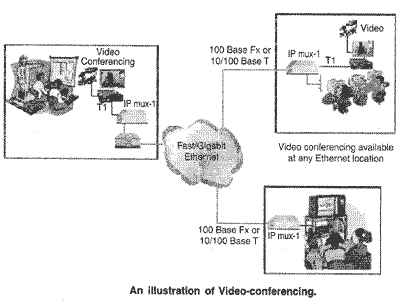A videoconference or video conference (also known as a video-teleconference) is a set of interactive telecommunication technologies which allow two or more locations to interact via two-way video and audio transmissions simultaneously. It has also been called ‘visual collaboration’ and is a type of groupware.
Videoconferencing uses telecommunications of audio and video to bring people at different sites together for a meeting. This can be as simple as a conversation between two people in private offices (point-to-point) or involve several sites (multi-point) with more than one person in large rooms at different sites. Besides the audio and visual transmission of meeting activities, videoconferencing can be used to share documents, computer-displayed information, and whiteboards.
Simple analog videoconferences could be established as early as the invention of the television. Such videoconferencing systems usually consisted of two closed-circuit television systems connected via cable. An example of that was the German Reich Postzentralamt (Post Office) network set up in Berlin and several other cities from 1936 to 1940.
During the first manned space flights, NASA used two radiofrequency (UHF or VHF) links, one in each direction. TV channels routinely use this kind of videoconferencing when reporting from distant locations, for instance. Then mobile links to satellites using specially equipped trucks became rather common.

Videoconferencing first demonstrated in 1968. This technique was very expensive, though, and could not be used for applications such as telemedicine, distance education, and business meetings. Attempts at using normal telephony networks to transmit slow-scan video, such as the first systems developed by AT&T, failed mostly due to the poor picture quality and the lack of efficient video compression techniques. The greater 1 MHz bandwidth and 6 Mbit/s bit rate of Picture phone in the 1970s also did not cause the service to prosper.
It was only in the 1980s that digital telephony transmission networks became possible, such as ISDN, assuring a minimum bit rate (usually 128 kilobits/s) for compressed video and audio transmission. The first dedicated systems started to appear in the market as ISDN networks were expanding throughout the world. Video teleconference systems throughout the 1990s rapidly evolved from highly expensive proprietary equipment, software and network requirements to standards based technology that is readily available.
to the genera! public at a reasonable cost. Finally, in the 1990s, IP (Internet Protocol) based videoconferencing became possible and more efficient video compression technologies were developed, permitting desktop, or personal computer (PC)-based videoconferencing, In 1992 CU-SeeMe was developed at Cornell by Tim Dorcey et al., IVS was designed at INRIA, VTC arrived to the masses and free services, web plug-in and software, such as NetMeeting, MSN Messenger, Yahoo Messenger, SightSpeed, Skype and others brought cheap, albeit low-quality, VTC.
 Dinesh Thakur holds an B.C.A, MCDBA, MCSD certifications. Dinesh authors the hugely popular
Dinesh Thakur holds an B.C.A, MCDBA, MCSD certifications. Dinesh authors the hugely popular